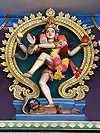|
narok
(นรก)
Thai term referring to 'hell',
a place comparable with Christian purgatory. The place is divided in
eight pits known as sanjihwa, kalasut(ra), sangkaht, rohruwon,
maharohruwon, tapon, patahpon and awejih. The abyss or deepest pit where
those with the most severe sins receive punishment is awejih. Hell is
presided over by Yama (in Thai called Phra Yom), the Vedic god of death,
who is also known as Yommaraat, the 'king of the realm of death'. He is
assisted by his envoy Yommathoot, the angel of death who has it as his
task to lead the souls of the dead to judgment before Yama and his
scribes Suwan and Suwaan. He is usually depicted with horns and holding
a trident or some other weapon. Temples often have gardens displaying
horrifying images, displaying beings called Yommabaan dealing out cruel
punishments to the wicked in the underworld. One punishment for the
wicked in the underworld is that they are forced to climb up the thorny
trunk of a ton ngiw, naked. The images of these punishments are used by
monks and novices for contemplation and meditation. The name narok is
derived from the Sanskrit word naraka. Also called Yommalohk and badahn.
See also kratha thong daeng.

_small.jpg)
Nataraja (नटराज)
Sanskrit. 'Dancer-king'. A depiction of Shiva as
the 'Lord of Dance' representing cosmic truth and energy. His cosmic
dance symbolizes creation, preservation and destruction at the same
time. He stands with one foot on a midget who represents 'ignorance'.
Statues of Nataraja are worshipped in most Hindu temples. See also
kalachakra and tandava.

 |